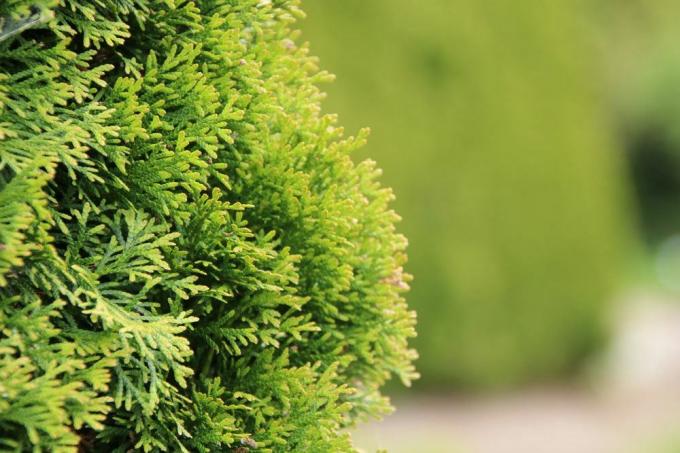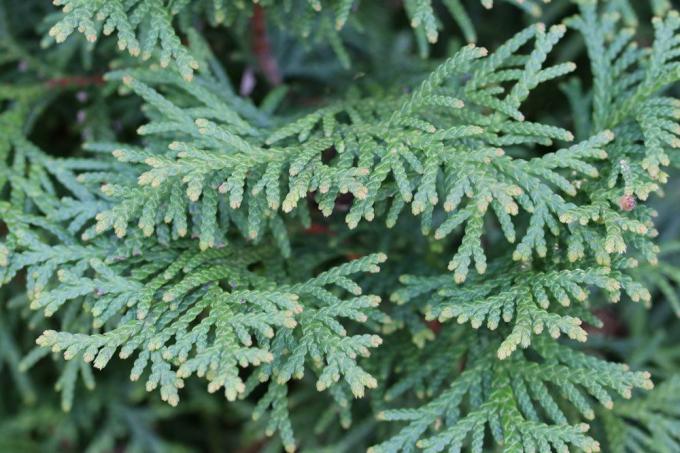
table of contents
- Thuja hedge growth
- Hedge height
- Location
- Thuja species
- Occidental thuja (Thuja occidentalis)
- Giant arborvitae (Thuja plicata)
- Oriental arborvitae (Platycladus orientalis)
Thujas are also commonly known as the trees of life. They are originally from North America and Eastern Asia and belong to the cypress family. In this country, different species and varieties are in culture. The specialist trade mainly offers the "Occidental Tree of Life" (Thuja occidentalis) and the "Giant Tree of Life" (Thuja plicata). Due to its rapid growth, the thuja is particularly well suited and popular for planting in hedges. An opaque, evergreen privacy screen is created in the garden in a very short time.
Thuja hedge growth
The thuja is very popular as a hedge plant because of its rapid growth. A dense one is created in a short time Privacy screen in the form of a living fence. It not only protects privacy from prying eyes, but also offers birds a nesting opportunity. The evergreen, pine-like wood also has other advantages to offer, for example:
- robust growth even in unfavorable locations
- quite undemanding, thrives wherever there is enough moisture
- good opaque branching due to scaly leaves
- frost hardy and windproof
- good cut tolerance
- very willing to grow
- reach considerable heights, freely growing up to 20 meters
- annual growth between 20 and 45 centimeters, depending on the variety
- not very maintenance-intensive
- inexpensive
Note: This wood is one poisonous plant. Even touching it can cause skin irritation. Small children and pets are particularly at risk if they swallow parts of plants.
Hedge height
Usually the "Thuja occidentalis" is mainly used for hedges. The fast-growing “Brabant” variety with its broad and bushy growth is very popular here. In a favorable location, such a hedge can reach a height of at least three meters and higher. This offers excellent privacy and noise protection.
How high a thuja hedge becomes can of course also be achieved through maintenance measures, i.e. through a regular annual one Cut backcan be individually designed. This stimulates the healthy development of the plants again and again. Depending on your needs, it can be done twice a year
- in spring (March to April) and
- in autumn (August to September)
In between, the tips can still be trimmed in May if the growth is rapid. It should also be noted that the vigor of the trees of life increases steadily with age.
tip: For a good development and healthy growth of the thuja Two to three plants should be planted per meter of hedge. At a height of 175 cm, one or two thujas are sufficient.
Location
The location also has a decisive influence on the development and also on the height of the Thuja. The effort for maintenance is almost minimal. All that is needed here is mulching to keep the moisture in the soil. Furthermore, adequate watering should be guaranteed in the event of prolonged drought. Love the pine-like plants
- a sunny to partially shaded location
- a soil that is not too dry
- Moist, well drained and slightly acidic soils preferred
- naturally also grow in swampy areas
In a shady place, the growth of the thuja stagnates. The growth is not very tall and dense. Planted as a hedge, the privacy screen leaves a lot to be desired. A relatively dry place should also be avoided, as thuja react quickly with brown needles.
tip: Since the trees of life belong to the year-round evergreen trees, they evaporate a lot of moisture through their leaves in winter. It is therefore necessary to water on frost-free days. As early as autumn, care should be taken to give plenty of water.
Thuja species
Mainly three different types are available in Central Europe, but many of them are available in specialist shops. As a rule, these differ in their stature and, therefore, in their height. Depending on the variety, the crown can be either narrow and conical. These thuja can reach a height of up to 15 meters. On the other hand, the shape of the crown can resemble a sphere or a column. These trees reach a maximum height of four meters.
Occidental thuja (Thuja occidentalis)
They are also traded as "common thuja". They originally come from Canada and North America and are mainly used as a hedge plant. A single planting can also be an eye-catcher. Is characteristic
- a restrained growth
- ideally suited for privacy protection
- achievable height 20 to 30 m
- Age up to 180 years
- Annual growth 35 to 50 cm depending on the variety
- mostly conical growth form
- rounded tip
- Upward branches
- Well-known representatives are: "Brabant", "Smaragd", "Columna" and "Yellow Ribbon".

Giant arborvitae (Thuja plicata)
This wood comes from the west of North America and is known under the common name "red cedar". There the thuja grows up to 70 meters in height. Due to the light and durable wood with a red-brown core, this tree is interesting for forestry. It is best suited for a solitary planting. The advantages of this type of thuja are:
- very fast growing
- Height in this country 10 to 15 m
- Spread 300 to 500 cm
- annual growth of up to 80 cm depending on location and variety
- very robust and hardy to more than -3 ° C
- Pyramidal habit
- Stems branched from top to bottom
- The leaves have a pleasantly fruity scent
- urban climate festival
- Popular varieties are: "Martin", "4ever Goldy", "Excelsa", "Atrovierens".
Oriental arborvitae (Platycladus orientalis)
The home is in East Asia at altitudes of 300 to 3300 meters. There they reach heights of up to 20 meters with a trunk diameter of up to one meter and an age of up to 1000 years. The oriental tree of life is commercially available, but not very widespread in Central Europe. The key features are:
- in this country growth height up to 10 m
- not quite hardy
- robust and easy to grow
- Crown initially conical to oval, with age round and irregular
- The varieties available in stores are: "Franky Boy" and "Aurea Nana" (dwarf gold thuja).

Note: When planting hedges with a stature height of over two meters is always a legal one Minimum distance to adhere to the neighboring property of one meter.




